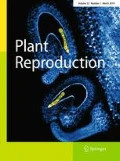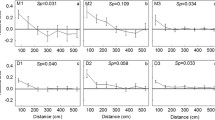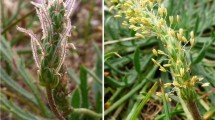Abstract
Gametophytes ofDryopteries filix-mas (L.) Schott were grown as isolates and as pairs of related and unrelated individuals. Reproductive efforts were generally highest among isolates, which reproduce by intragametophytic selfing only. Reproductive success ofD. filixmas may depend on the abundance of resources rather than the actual mating system employed. The estimates of the amount of genetic load for the two populations examined were low, 10% and 16%, respectively. The great numbers and the high viability of sporophytes produced by intragametophytic selfing indicate thatD. filix-mas does not experience serious inbreeding depression.
Similar content being viewed by others
References
Barker J, Willmot A (1985) Preliminary studies on the breeding systems ofDryopteris filix-mas (L.) Schott andD. dilatata (Hoffm.) A. Gray, Proc R Soc Edinburgh 86B:455–456
Crist KC, Farrar DR (1983) Genetic load and long-distance dispersal inAsplenium plaryneuron. Can J Bot 61:1809–1814
Döpp W (1950) Eine die Antheridienbildung bei Farnen fördernde Substanz in den Prothallien vonPteridium aquilinum (L.) Kuhn. Ber Dtsch Bot Ges 63:139–159
Hedrick PW (1987) Genetic load and the mating system in homosporous ferns. Evolution 41:1282–1289
Holsinger KE (1990) The population genetics of mating system evolution in homosporous plants. Am Fern J 80:153–160
Klekowski EJ Jr (1969) Reproductive biology of the Pteridophyta III. A study of theBlechnaceae. Bot J Linn Soc 62:361–377
Klekowski EJ Jr (1970) Reproductive biology of the Pteridophyta IV An experimental study of mating systems inCeratopteris thalictroides (L.) Brongn. Bot J Linn Soc 63:153–169
Klekowski EJ Jr (1973) Genetic load inOsmunda regalis populations. Am J Bot 60:146–154
Korpelainen H (1994) Growth, sex determination and reproduction of Dryopterisfilix-mas (L.) Schott gametophytes under varying nutritional conditions. Bot J Linn Soc 114:357–366
Korpelainen H (1995a) Growth and reproductive characteristics in artificially formed clonal gametophytes ofDryopteris filix-mas (Dryopteridaceae). PI Syst Evol 196:195–206
Korpelainen H (1995b) Mating system and distribution of enzyme genetic variation in bracken (Pteridium aquilinum). Can J Bot 73:1611–1617
Korpelainen H, Kolkkala M (1996) Genetic diversity and population structure in the outcrossing populations ofEquisetum arvense andE. hyemale (Equisetaceae). Am J Bot 83:135–141
Lande R, Schemske DW (1985) The evolution of self-fertilization and inbreeding depression in plants. I. Genetic models. Evolution 39:24–40
Manton I (1950) Problems of cytology and evolution in the Pteridophyta. Cambridge University Press, Cambridge, UK
Näf U, Nakanishi K, Endo M (1975) On the physiology and chemistry of fern antheridiogens. Bot Rev 41:315–359
Peck JH, Peck CJ, Farrar DR (1990) Influence of life history attributes on formation of local and distant fern populations. Am Fern J 80:126–142
Schemske DW, Lande R (1985) The evolution of self-fertilization and inbreeding depression in plants. II. Empirical observations. Evolution 39:41–52
Soltis DE, Soltis PS (1987) Breeding system of the fernDryopteris expansa: evidence for mixed mating. Am J Bot 74:504–509
Soltis DE, Soltis PS (1992) The distribution of selfing rates in homosporous ferns. Am J Bot 79:97–100
Soltis PS, Soltis DE (1990) Genetic variation within and among populations of ferns. Am Fern J 80:161–172
Sorsa V (1958) Chromosome studies on Finnish Pteridophyta I. Hereditas 44:541–546
Warne TR, Lloyd RM (1981) Inbreeding and homozygosity in the fern,Ceratopteris pteridoides (Hooker) Hieronymus (Parkeriaceae). Bot J Linn Soc 83:1–13
Werth CR (1991) Isozyme studies on theDryopteris “spinulosa” complex. I. The origin of the log fernDryopteris celsa. Syst Bot 16:446–461
Wolf PG, Sheffield E, Haufler CH (1991) Estimates of gene flow, genetic substructure and population heterogeneity in bracken (Pteridium aquilinium). Biol J Linn Soc 42:407–423
Author information
Authors and Affiliations
Rights and permissions
About this article
Cite this article
Korpelainen, H. Intragametophytic selfing does not reduce reproduction inDryopteris filix-max. Sexual Plant Reprod 9, 117–122 (1996). https://doi.org/10.1007/BF02153059
Received:
Accepted:
Issue Date:
DOI: https://doi.org/10.1007/BF02153059




